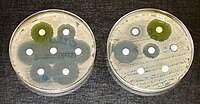
Photo from wikipedia
Objectives The features of a newly established, web-based surveillance system for hospital antibiotic consumption are described and data on broad-spectrum antibiotic use in German acute care hospitals are presented. Methods… Click to show full abstract
Objectives The features of a newly established, web-based surveillance system for hospital antibiotic consumption are described and data on broad-spectrum antibiotic use in German acute care hospitals are presented. Methods The watch- and reserve-group antibiotics, two categories of antibiotics derived from the WHO Essential Medicines List comprising key agents for antimicrobial stewardship, were used as a framework for data analysis. The median antibiotic consumption densities (ACDs; DDD/100 patient days) for the years 2015/16 based on data from 137 acute care hospitals have been calculated for whole facilities, ICUs and medical and surgical departments, stratified by type of care. Results The new web-based system provides real-time surveillance at unit and facility levels, accessible to all relevant stakeholders. User-defined reports are available via an interactive database, various report types support different approaches to analysis, and different complementing quantification measures of antimicrobial consumption are available. Watch- and reserve-group antibiotics accounted for 42% and 2% of total antibiotic use, respectively. Surgical services presented with considerably lower median ACDs of the watch-group antibiotics compared with medical services. Tertiary care hospitals exhibited higher ACDs of the reserve-group antibiotics and carbapenems than primary/secondary care hospitals, while the ACDs of the watch-group antibiotics as a whole did not differ significantly. Comparing the proportional use with other European countries revealed a relatively high use of the watch-group, ranking beyond the 75th percentile. Conclusions Because of its particular features the new web-based surveillance system is a valuable tool for antimicrobial stewardship. The WHO categories of watch- and reserve-group antibiotics proved to be a useful framework for the analysis of hospital antibiotic consumption data.
Journal Title: Journal of Antimicrobial Chemotherapy
Year Published: 2018
Link to full text (if available)
Share on Social Media: Sign Up to like & get
recommendations!